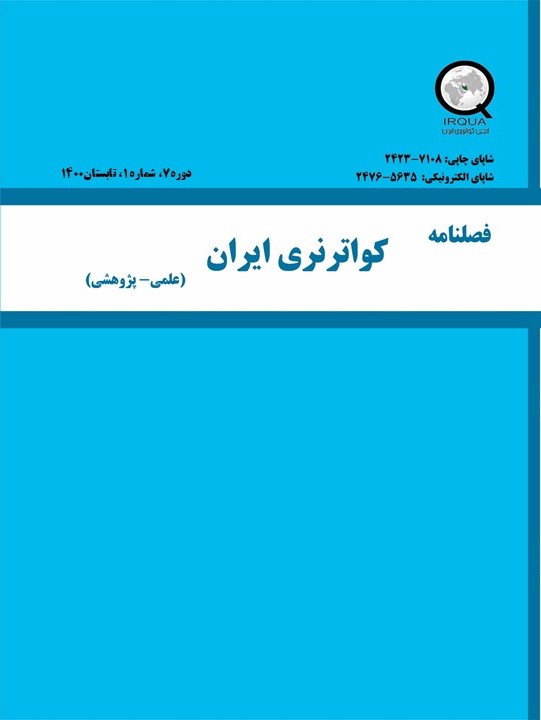نوع مقاله : مقاله پژوهشی
نویسندگان
گروه زمین شناسی، واحد لاهیجان، دانشگاه آزاد اسلامی، لاهیجان، ایران
چکیده
رودخانه ها از مهمترین منابع آبی بوده و بررسی کیفیت آب آن ها بسیار حیاتی می باشد. از این رو در این مطالعه از 15 ایستگاه آبراهه های دائمی پیربادوش و گشون رودخانه قلیان استان لرستان که در مسیر شیل های نفتی قرار دارند، نمونه برداری صورت گرفت. با آنالیز نمونه ها در آزمایشگاه، پارامترهای هیدروژئوشیمیایی محاسبه شدند و سپس مقایسه با استانداردها و رسم نمودارهای هیدروژئوشیمیایی جهت بررسی کیفیت آب شرب منطقه انجام شد. نتایج نشان داد، آب رودخانه قلیان حاوی کربنات کلسیم فراوانی است (به جزء نمونه P3 که مقدار بیشتری کربنات منیزیم دارد) که به دلیل دارا بودن کلسیم بالا برای نوشیدن نامناسب، ولی بر اساس سایر پارامترها مناسب است. بر اساس طبقه بندی کیفی شولر، نمونه های گشون کیفیت پایین تری نسبت به پیربادوش دارند و طبق استانداردها، اکثر نمونه ها در حد مجاز-مطلوب می باشند. براساس نمودارهای هیدروژئوشیمیایی، کیفیت آب آبراهه پیربادوش بهتر از گشون است و بر اساس نمودار گیبس، سنگ های بستر و هوازدگی و انحلال از عوامل اصلی کنترل کننده شیمی آب منطقه هستند. در این منطقه نوع واحدهای سنگی و حتی وجود شیل های نفتی تأثیر مخربی بر کیفیت آب شرب منطقه نداشته است.
کلیدواژهها
موضوعات
عنوان مقاله [English]
Investigation of hydro-geochemical quality of surface water for drinking water use (Case study: Qalikuh region, Lorestan province, southwest of Iran)
نویسندگان [English]
- Amir Saeed Hosseini
- Saeed Hakimi Asyabar
- Mozhgan Salvati
Department of Geology, Lahijan Branch, Islamic Azad University, Lahijan, Iran
چکیده [English]
Introduction
Rivers are one of the most important water resources and it is very important to study their water quality. Therefore, in this study, sampling was done from 15 permanent waterway stations of Pirbadush and Gashun of Qolyan River in Lorestan province, which are located in the path of oil shales.
Materials and Methods
Hydro-geochemical parameters were calculated by analyzing the samples in the laboratory. Then compared with drinking water quality assessment standards in the region and Hydro-geochemical diagrams were also drawn.
Discussion and Results: Qolyan River water contains a lot of calcium carbonate and only sample P3 has more magnesium carbonate that it is unsuitable for drinking due to its high calcium content, but it is suitable based on other parameters.
Results
According to Schoeller quality classification, Gashun samples are of lower quality than Pirbadush and by the standards, most samples are within the allowable-favorable range and water of G6, G7, P5 stations have lower quality than other stations. According to the WHO table, the water of the Qolyan River is relatively light in terms of TH and total dissolved solids (TDS) and relatively light in terms of Electrical conductivity (Ec). Based on hydro-chemical tests and data analysis and hardness estimation and comparison with the national standard of Iran and the standard of the World Health Organization, the results of water classification of the samples are as follows: According to the World Health Organization's calcium ion (Ca2 +) content, water samples from G7 and P5 stations are impermissible and based on the total hardness of the Iranian national standard, the water samples of stations P1 and P3 are in the favorable level.
According to hydro-geochemical diagrams, the water quality of Pirbadush waterway is better than Gashun. According to the Piper diagram, In Gashun samples, the tendency of the samples towards magnesium and sulfatation is more than the samples of Pirbadush region. According to the Durov diagram, most of the water samples taken from Gashun and Pirbadush waterways are calcium carbonate (Ca-CO3) and calcium bicarbonate (Ca-HCO3). According to Schoeller diagram, the amount of tumble in the samples of Gashun waterway is more than Pirbadush waterway. According to the ion equilibrium diagram, the amplitude of change of anions and cations in Gashun waterway is more than Pirbadush. According to Stiff diagram, the different origins of the samples indicate the existence of several bedrock sources for the samples, and according to the Gibbs diagram, bedrock and weathering and dissolution are the main factors controlling the water chemistry of the region.
By examining the water quality of Qolyan River in Pirbadush and Gashun waterways with any human activity that it is in the path of oil shales, the results were obtained which are:
-The highest amount of cations and carbonate anion (CO32-), is in G7 station and the highest amount of nitrate anion (NO3-), are in G6 and P7 stations.
-The highest water total hardness (TH) is related to stations G7, G6, P5 and the lowest is related to stations P3, P1, G1.
-The highest total dissolved solids (TDS) in water is related to stations G6, G5, G7 and the lowest amount is related to P1, P4, P3.
- The presence of higher amount of calcium carbonate (Ca-HCO3) in Gashun waterway than Pirbadush indicates a higher degree of solubility of calc than dolomite in this section.
- High sulfate content in Gashun waterway (especially G1 station) can be related with further dissolution of anhydrites in the Gotnia Formation.
-Anion and cation equilibrium also shows that ionic equilibrium is present only at stations G3, G5, P6. However, at stations P1 and P3, there is a high degree of ionic imbalance between anions and cations.
Conclusion
In this area, the type of rock units and even the presence of oil shales have not had a detrimental effect on the quality of drinking water.
کلیدواژهها [English]
- Drinking water
- Qolyan River
- Qalikuh
- Oil shales
- Hydro-geochemical diagrams

